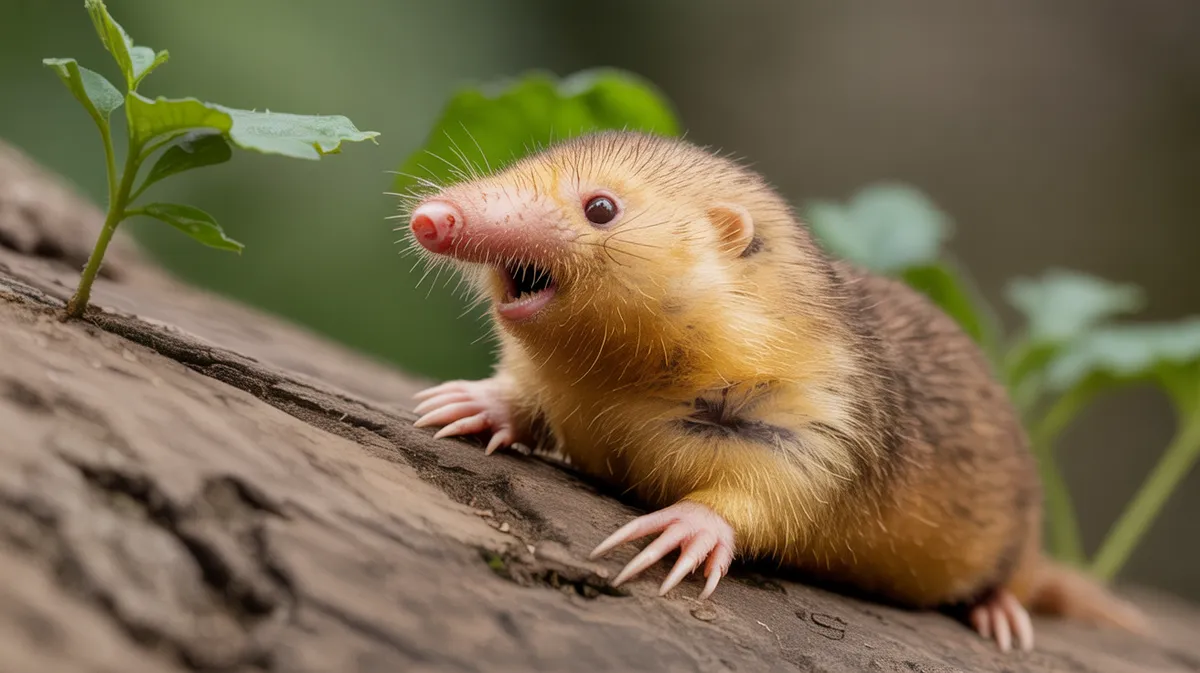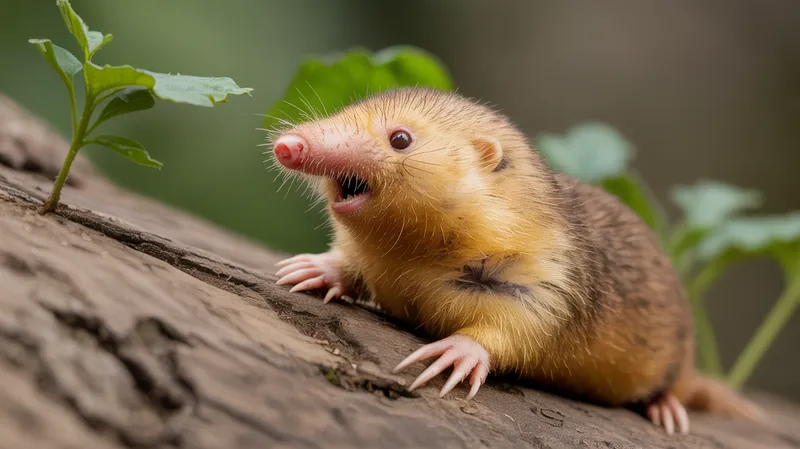
Giant Golden Mole
Chrysospalax trevelyani

Meet the Giant Golden Mole
The Giant Golden Mole is a rare, subterranean mammal endemic to the forests of South Africa. Characterized by its dense, iridescent fur that shimmers with golden to bronze hues, this species is highly adapted for a fossorial lifestyle, with powerful forelimbs and reduced eyesight. Unlike true moles, golden moles are not closely related to other mole species and belong to their own order, Afrosoricida. The Giant Golden Mole plays a crucial ecological role in aerating the soil and controlling insect populations, but it is increasingly threatened by habitat loss and fragmentation.
Classification
Mammal
Habitat
Temperate and subtropical forests
Diet
Carnivore
Lifespan
4-6 years
Conservation
Endangered
Weight
400-700 grams
📖Fascinating Facts
Shimmering Coat
The Giant Golden Mole's fur is iridescent and appears golden or bronze, which helps it move smoothly through soil.
Expert Burrower
Its powerful, spade-like forelimbs and reduced eyes make it perfectly adapted to a life spent tunneling underground.
Forest Specialist
This mole is only found in a few isolated forest patches in South Africa, making it highly susceptible to habitat loss.
📋Detailed Description
The Giant Golden Mole (Chrysospalax trevelyani) is the largest member of the golden mole family, reaching a head-body length of 21–23 cm and weighing up to 500 grams. Its dense, velvety fur exhibits an iridescent sheen, ranging from bronze to greenish-gold, which is thought to reduce friction as the animal moves through soil. The body is cylindrical and streamlined, with a conical head and a leathery, naked nose pad adapted for burrowing. Eyes are vestigial and covered by skin and fur, rendering the animal effectively blind, while external ears are absent, reducing drag underground. The forelimbs are robust and equipped with enlarged, pick-like claws, particularly on the third digit, facilitating powerful digging. Hind limbs are shorter and less developed, aiding in soil displacement. The Giant Golden Mole possesses a unique ossified auditory bulla and hypertrophied malleus bones, adaptations that enhance its sensitivity to seismic vibrations, allowing it to detect prey and predators underground. This species is strictly subterranean, rarely emerging above ground except during dispersal or after heavy rains. It is solitary and territorial, with individuals maintaining extensive tunnel systems beneath the forest floor, often in moist, well-drained soils rich in leaf litter.
💡 Did you know?
Despite their name, golden moles are more closely related to tenrecs and elephant shrews than to true moles.
🔬Research & Sources
Wikipedia Summary
The giant golden mole is a small mammal found in Africa. At 23 centimetres (9.1 in) in length, it is the largest of the golden mole species. This mole has dark, glossy brown fur; the name golden comes from the Greek word for green-gold, also the source of the name of the family, Chrysochloridae.
Last Modified: 11/28/2024
🎭Behavior & Social Structure
Giant Golden Moles are predominantly nocturnal and crepuscular, spending most of their lives in self-excavated burrow systems. They are solitary, with each individual occupying a distinct home range and aggressively defending its territory from conspecifics. Foraging occurs primarily just below the leaf litter, where the mole hunts for invertebrates such as earthworms, beetle larvae, termites, and occasionally small vertebrates. It uses its sensitive snout and vibrational hearing to locate prey, often pausing to detect subtle ground movements. Feeding bouts are interspersed with periods of rest in deep nesting chambers. Above-ground activity is rare and typically associated with dispersal events or after heavy rainfall, which can flood burrows. Communication is limited, relying mainly on scent marking and possibly low-frequency seismic signals. There is little evidence of social interaction outside of the breeding season.
👶Reproduction & Life Cycle
Breeding in the Giant Golden Mole is believed to be seasonal, with most reproductive activity occurring during the South African summer (October to March), coinciding with increased food availability. Courtship is poorly documented but likely involves scent cues and brief encounters between males and females. After mating, the female constructs a specialized nesting chamber lined with plant material. Gestation lasts approximately 4–6 weeks, after which a single offspring (rarely two) is born altricial and blind. The young remain in the nest for several weeks, receiving maternal care and nourishment until they are sufficiently developed to begin independent foraging. Weaning occurs at around 4–5 weeks, and juveniles disperse soon after, establishing their own territories. Reproductive rates are low, contributing to the species' vulnerability.
🛡️Adaptations & Survival
The Giant Golden Mole exhibits a suite of remarkable adaptations for fossorial life. Its powerful forelimbs and enlarged claws enable efficient tunneling through dense forest soils. The fur's iridescent quality is not only visually striking but also functionally important, as the flattened, silky hairs reduce friction and help shed soil particles. The animal's auditory system is highly specialized: the hypertrophied ossicles and closed ear canals allow it to detect low-frequency ground vibrations, compensating for its lack of vision. Metabolic rates are low, an adaptation to the hypoxic conditions of underground environments. The mole's kidneys are efficient at conserving water, allowing survival in variable moisture conditions. Behavioral adaptations include a solitary, territorial lifestyle and the construction of deep, complex burrow systems that provide protection from predators and environmental extremes.
🎨Cultural Significance
The Giant Golden Mole holds little direct significance in local folklore or traditional medicine, likely due to its secretive, subterranean habits and rarity. However, golden moles as a group are sometimes referenced in South African culture as symbols of the hidden or unseen, reflecting their elusive nature. There are no known traditional uses or widespread myths specifically associated with this species. Its conservation status has, however, made it a flagship species for forest conservation efforts in the Eastern Cape, raising awareness of the region's unique biodiversity.
🔬Recent Research & Discoveries
Recent research has focused on the Giant Golden Mole's bioacoustic adaptations, particularly its ability to detect seismic signals in the absence of functional vision. Studies using micro-CT scans have revealed the extraordinary morphology of its middle ear bones, providing insights into convergent evolution among subterranean mammals. Ongoing fieldwork aims to map the species' distribution more accurately, as many populations remain poorly surveyed due to their cryptic lifestyle. Genetic studies are underway to assess population structure and connectivity, which are critical for effective conservation planning. There is also interest in understanding the mole's ecological role in soil aeration and nutrient cycling, as well as its responses to habitat restoration initiatives.
🎥Wildlife Videos

Blind golden mole looks for termites - Planet Earth: Deserts - BBC
#bbc.
BBC

The Golden Mole: Completely Blind and No Bigger Than A Ping Pong Ball - Planet Earth II
The Golden Mole may be blind and tiny, but it can strike at its prey with pinpoint accuracy. Coming to BBC America in early 2017.
BBC America

Adorable Golden Mole Is Sneaky | Animal Camera | BBC
Wildlife expert Steve Leonard travels to the desert and finds a golden mole hiding. Subscribe: http://bit.ly/BBCStudios WATCH ...
BBC Studios

Desert Golden Mole
I just fell in love with this little golden mole! (: This is from the first episode of "Night on Earth" on Netflix. Season 1, episode 1.
Amy Putnam

Conservationists find extinct golden mole
A team of conservationists found an extinct mole that likes to hide in the sand. It's blind and nocturnal. .
WPLG Local 10

50|50 Series: In Die Spervuur - Golden Mole
"In die Spervuur" is an environmental series of separate inserts that SANHU Productions were commissioned to produce in 2016 ...
SANHU Productions
🌍Habitat Information
The Giant Golden Mole typically inhabits Temperate and subtropical forests environments. Giant Golden Moles have adapted to their environments with specialized features and behaviors.
Primary Habitat:
Temperate and subtropical forests
More detailed habitat information will be available soon.
🛡️Conservation Status
The Giant Golden Mole is currently classified as Endangered. Conservation efforts are crucial for preserving this species for future generations.
Common Threats:
- 🏠Habitat loss and fragmentation
- 🌡️Climate change impacts
- 🎯Hunting and poaching
- 🏭Human-wildlife conflict
⚠️Threats & Conservation Challenges
The primary threats to the Giant Golden Mole are habitat loss and fragmentation due to commercial forestry, agriculture, and urban development in the Eastern Cape forests of South Africa. Logging and conversion of indigenous forests to pine and eucalyptus plantations have significantly reduced suitable habitat. Road construction and human encroachment further isolate populations, impeding gene flow. The species is also sensitive to soil compaction and changes in moisture regimes, both of which can degrade burrow quality. Predation by domestic dogs and cats, as well as natural predators like mongooses, poses additional risks. Population trends are declining, with the species currently listed as Endangered by the IUCN. Conservation challenges include the need for habitat protection, restoration of indigenous forests, and public awareness campaigns to reduce persecution and accidental mortality.
🔬Scientific Classification
Scientific Name
Chrysospalax trevelyani
Classification Hierarchy
🔍 About Taxonomic Classification
Taxonomic classification is a hierarchical system used by scientists to classify and organize living organisms based on shared characteristics and evolutionary relationships.
The system moves from broad categories (Kingdom) to increasingly specific ones, with each animal's scientific name typically consisting of its Genus and species.
📝Community Notes
Share your observations and insights about the Giant Golden Mole with our community of wildlife enthusiasts.
Join Our Community
Sign in to share your observations and connect with fellow wildlife enthusiasts.
Sign In to ContributeNo community notes yet
Be the first to share your observations about the Giant Golden Mole!
Explore Giant Golden Mole
Select a tab above to learn more about this amazing animal.
📸Photo Gallery
No photos available for this animal yet.
🌟Discover More Wildlife
Continue your journey of discovery with more fascinating animals from our database
